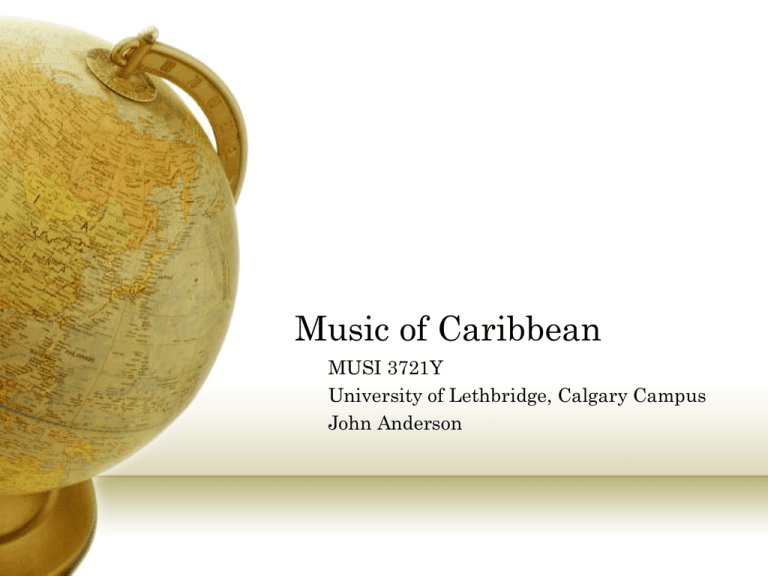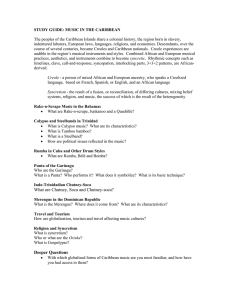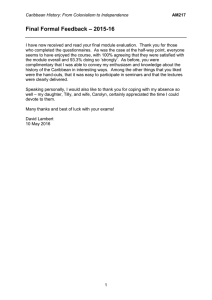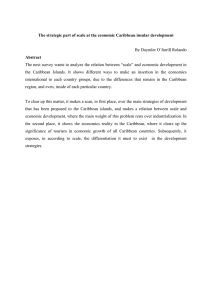Music of Caribbean MUSI 3721Y University of Lethbridge, Calgary Campus John Anderson
advertisement

Music of Caribbean MUSI 3721Y University of Lethbridge, Calgary Campus John Anderson Key Concepts Shared Colonial Experiences • Filtered through local circumstances, negotiated in particular contexts, entered into at different historical moments, interpreted in diverse ways Key Concepts Creolization • The process of mixing African and European peoples, cultures, and languages, via colonialism, creating the Creole cultures of the Caribbean Syncretism and Hybrid • The process of mixing cultural elements and creating a new, and resultant, product (the hybrid) Key Concepts Musical Reception • Under colonialism, local Caribbean music was for the slave and underprivileged class, scorned by the ruling class • Today, the music is received openly in a global market, especially reggae Key Concepts Identity • Creole, hybrid forms that emerged under colonialism are today symbols of national identity Tourism • Caribbean music has become globalized. Caribbean immigrants bring their music where they go, while tourists to the Caribbean purchase the cultural products and disseminate them Key Concepts Class and Cultural Politics • During the colonial era, the government and its elites feared and banned musical forms that roused the masses • In the 20th century, singers, especially calypso singers in Trinidad and reggae singers in Jamaica, use their vocal genres to criticize government policies and politicians Musical Syncretism, Creole Music • Let’s listen to different examples of Caribbean music • Write two lists • African instruments and concepts • European instruments and concepts Musical Syncretism, Creole Music • The syncretism has taken a whole new Creole sound, but the instruments and elements can be recognized as either African or European “Times Table,” by Ophie and the Websites • Characteristic of rake-nscrape • The accordion begins and is immediately accompanied by strong foot stomping • Marks the basic pulse throughout • The saw and goat-skin drum enter and accent the off beats • The “and” of each beat (one AND two AND, three AND… “Times Table,” by Ophie and the Websites • The saw player bends and releases the saw • This creates different timbral effects • Gives the impression of changing the pitch “No, Doctor No,” by The Mighty Sparrow • The ensemble includes a horn line, upright bass, guitar, and percussion • Reflects the modern calypso sound • Sparrow’s lyrics politics in 1957 • Critical of the government’s failure to come through on campaign promises “No, Doctor No,” by The Mighty Sparrow • Verse-chorus structure • Call-and-response during the chorus • Music secondary to the lyrics • Aggressive tone of lyrical content • Typical characteristics of calypso Punta • A song genre that symbolically reenacts the cock-and-hen mating dance • Usually composed by women • Performed during festivals, at wakes, and at celebrations that follow dugu ceremonies • religious ceremonies during which a family appeals to the ancestors for help in solving a given problem Punta • Punta usually involves call and response singing, drums, rattles, and sometimes conch shell trumpets • The drums used in punta are called the primero and the segunda • Punta Rock is a popular music style developed by the Garifuna peoples from punta Discussion Questions • With which globalized forms of Caribbean music are you most familiar, and how have you had access to them? • Can we think of any other music and cultural syncretisms than those found in the Caribbean? • Where are they? What were their influencing cultures? Discussion Questions • Do we regard any form of music as a symbol of our national identity as Caribbean nationals do? • What is your music? • What forms of political protest music exist in cultures outside of the Caribbean • Consider Canada, the United States, China, Africa, and Latin America for starters


